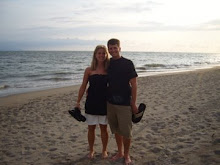So, I haven't posted in a few days. A quick update- yesterday was a busy day. We spent the morning on an alternative tour with ICAHD (Israeli Committee against home demolitions), in which we drove through West Jerusalem (the majority are Israelis) and East Jerusalem (with the majority being Palestinians with the exception of several Israeli Settlements in once inhabited Palestinian homes). Quick Stats about East Jerusalem- 78% of the children are growing up underneath the poverty line. 50% failure rate for education. The schools that are fortunate to exist have no air or heat. The municipality spends 480 NIS per Palestinian child on education and 2850 NIS per Israeli student. Settlements are built in less than a year, while one school has taken 6 years to build and is still not open. Also, joined a protest with the Women in Black in West Jerusalem. They have been doing this protest to end the occupation every friday since 1988. We then joined a larger protest in Sheikh Jarah against recent and planned evictions and Israeli Settlements. Those present included Orthodox Jews, Rabbis for Human Rights, CPT, and The world Council of Churches. Heard the owner of the house talk of his eviction. He had a contract to live in the house between Jordan and Israel. He had been living there since 1962. An Isreali family now lives where his children used to sleep. They did not recognize his legal right to his home.
Today we drove south to The Negev. We visited and ate with three bedouin communities. After 1948, the Arab Bedouins (who had been on the land for hundreds of years) were forced to either leave or been restricted to an area called the Siak (?). The siak is an area of the Negev that is tremendously smaller than what is needed to maintain there lifestyle. The Israeli govt. has given them Israeli citizenship but refuses to recognize any Bedouin that lives in a village rather than a town. A town is much smaller and condensed with little access to the land. It would mean an entire cultural change that has lasted over centuries. Rather than discussing the blatant injustice (like destroying a man's house two days before his wedding- no new structures are allowed to be built), I want to talk about their hospitality. At each village, we were welcomed into their home. We sat down with them as they told us their story. As we talked, we were served water, tea, and fruit (dates, cactus fruit). Three times today I sat down and received their offer of friendship and hospitality. In return, they asked that I tell their story. The Bedouins are often not talked about. The last village we met with has just received a demolition order. Some time in the next two weeks, bulldozers will come and destroy their homes. I talked with Aziz. His grandfather purchased their land back when the Ottoman Turks were still ruling. The British respected their rights, but Israel will not recognize their deed. They say it unable to be authenticated. He has five children and shared his desire to live peacefully with and on the land of his family. The land is their home. It is where they have history and memory. The land is part of who they are. It could be gone next week.
Tomorrow, I head to Bethlehem. We may get a call later this week to help the Bedouins in nonviolent resistance. For now, we're going to continue with the itenerary. To Bethlehem.
Subscribe to:
Post Comments (Atom)

2 comments:
When you say that the Israeli govt. does not recognize Bedouin people unless they live in towns... does that mean, voting rights, etc? Can you also tell about anything you learn re: Arab Israeli citizens' rights/inequality/violation of rights? I remember hearing a little about it, but would like to learn more.
Yeah, the Israeli govt. doesn't recognize the villages. Meaning, they aren't on the map. They don't have water, medicine clinics, or electricity. Human Rights organizations have appealed to the courts for schools, so they created a traveling school that occasionally gets around. one of the villages had to send their children 40 kilometers to get to school each morning.
Post a Comment